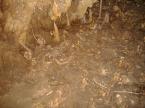Information
Târnăveni (Hungarian: Dicsőszentmárton, German: Sankt Martin) is a city and municipality in central Romania, county Mureş. It lies on the river Târnava Mică.Tarnaveni is crossed by the Blaj-Praid railroad, and also by DN 14A Iernut-Medias,DJ 117 Tarnaveni-Blaj, DJ Tarnaveni-Capalna-Ungheni and by DJ 142 Tarnaveni-Balauseri. Tarnaveni is situated at the following distances from :
- Bucharest - 360 km
- Targu Mures - 45 km
- Cluj-Napoca - 102 km
- Sibiu - 78 km
- Medias - 25 km
- Blaj - 36 km
History
The archaeological research proved the presence of human communities in these parts as dating from times immemorial. In 1921, traces of a Neolithic settlement were discovered; a collection of 135 imperial Dinars and two silver balls were found. The place was historically certified in 1279, under the name of terra Dychen Sent Marton (Diciosânmartin), in a land relocations and ownership document.In 1502, the place was mentioned as borough - oppidum, as a part of Cetatea de Balta fields, owned in the 15th-16th centuries by Moldavian rulers- Stephen the Great, Petru Rares and others. Since vineyards covered the majority of the cultivated land, it came to be known as the " vine country" - Weinland. For a few centuries until the half of the XX century, the city proved to be of a great regional interest, becoming even the capital of a shire (Târnava shire), or a county capital (Târnava Mica County), alternating this attribute with Cetatea de Balta or with Blaj.The last years of the 19th century and the first years of the 20th century marked the urban evolution of the place, since many administrative and social-economic buildings were erected. In 1866 it became the Târnava shire capital. It was during those years that the administrative palace and the hospital were built; the great doctor C.I. Parhon used to consult patients here, his family originating from Cetatea de Balta.In 1912, the place was declared town, and in 1941 it received the name of Târnaveni.The discovery of methane gas radically changed the city history. Gas was introduced in houses in 1915 and, after the war, a calcium carbide and calcium cyanamide factory was set up, followed by the Nitrogen company and later by a soot black factory. The inhabitants brought their huge contributions to the events of the 20th century, taking part in the Great National Assembly in Alba-Iulia , on the 1st of December, 1918. In 1936, an installation of synthetic ammonia production was set in Târnaveni, the first of this type in the world. Later, the company switched to warfare production. World War II left deep traces in the lives of the inhabitants: 230 Romanian heroes are resting in the local cemetery. After the war, the town industry witnessed a continuous development. In 1957, for the first time in the country, vinyl polychlorinate was produced here. A modern glassware factory - Gecsat - is situated in the southeast area, producing a wide range of export products.Great historical and cultural personalities were involved in the life of Târnaveni. The coryphaeus of " Scoala ardeleana"("Transylvanian School"), Petru Maior, is a native of the town. Historians state that his father, Gheorghe Maior, lived in 1750 in Târnaveni, serving as a priest in the Seuca parish.During the 1848-1949 Revolution, Târnaveni was a part of the 3rd Legion, Cetatea de Balta, of Avram Iancu's army. Vasile Moldovan, the great fighter for national emancipation, was the prefect. After the defeat, he settled in Bozias, where one can find his tomb. According to George Calinescu, Mihai Eminescu might have passed through Târnaveni, on his way to Blaj (1866), staying at the central wine cellar.In 1962, the Museum of History was settled, having archaeology, ethnography, nature sciences and numismatics departments. The Unitarian Church built in gothic style in the 13th century, redecorated in 1599, (the church owns a silver glass from 1636, a silver plate and a bell dating from 1678), the wooden Christian Church, brought from the Cornesti village, whose interior was painted by Nicolae Pop. The Bozias School was set up in 1780. Târnaveni became a municipality on the 5th of November 1998.
Population
These days it has 26,300 inhabitants (2004), and it is 84<sup>th<sup> large city in Romania.From official census data:
- 1977 - 26.073
- 1992 - 30.520
- 2002 - 26.537
Turistic Objectives
The Museum
Created in 1962, the city musem shows the visitors a great collection of archeological relicves, and also, many etnographic materials from Valea Tarnavelor.
The Unitarian Church
Gothic-style construction, built in the XV century.
Other turistic objectives
- "Sf.Treime" cathedral, built in 1939-1940, and the catholic curch.
- Only 15 km distance from Tarnaveni to Blaj in Cetatea de Balta you can find the a Medieval Castle, built in 1570-1580.
- Interesting tourism sites, such as: the " Corona" forest, located on the inter-river Mures- Târnava Mica
External links
- History of the city (Romanian)
- The World Gazetteer
Forrás: Wikipedia
Târnăveni

 English
English









